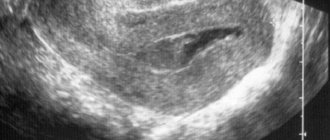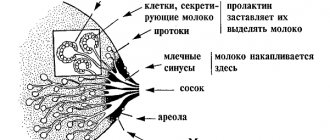The concept of basal temperature
Basal body temperature (abbreviated BT) is measured differently than you are usually used to for a flu or cold. To obtain an accurate reading, place the thermometer in the mouth, vagina or anus. This temperature will vary throughout the entire monthly cycle.
This is caused by the peculiarities of the reproductive cycle. As is known, it consists of several phases, each of which is characterized by certain characteristics:
- follicular;
- ovulation;
- luteal
In each of these phases, the concentration of sex hormones in a woman’s body is different. Namely, basal temperature depends on the level of progesterone and estrogen.
By the way, it should be noted that measuring BT fluctuations can be used for so-called “calendar contraception,” that is, calculating certain days of the menstrual cycle during which sexual intercourse cannot lead to fertilization of the egg.
Causes of low basal temperature
Before answering the question of why low basal temperature occurs during pregnancy, you need to understand the reasons that could provoke this circumstance. Among them:
- Corpus luteum deficiency. In this case, we are talking about progesterone, which prevents the onset of menstruation and is responsible for the production of the corpus luteum hormone. If it is not enough, then BT increases slowly and a new pregnancy is in danger of failure. The graph shows that before menstruation there is no drop in temperature, and this may indicate hormonal deficiency, which in itself will prevent pregnancy.
- Hormonal imbalance. When, after ovulation, against the background of low temperature in the second phase, a slight rise in temperature is observed on the graph, this may indicate a lack of progesterone and estrogen. As a rule, this process in the female body is accompanied by nagging pain in the lower abdomen, in the lumbar region, as well as spotting.
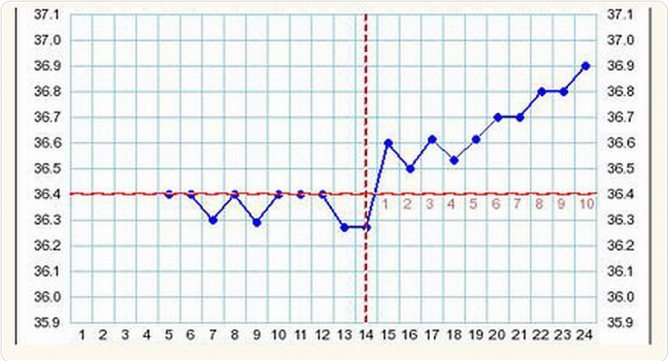
- An error in taking measurements is a common reason why your BT gives an error.
- Fatigue or overwork.
- Sexual intercourse on the eve of diagnosis.
- The woman ate too much spicy food, causing her basal temperature to drop sharply.
- Endocrine pathologies.
- Other physiological features.
Be that as it may, a decrease in BT is an alarming signal and a reason to contact an antenatal clinic. Make charts, undergo a series of specific examinations and tests, on the basis of which the gynecologist will draw his conclusions and be able to prescribe treatment if necessary.
Deviations in basal temperature from the norm may indicate the following processes:
- a high rate indicates a lack of estrogen;
- a “low” number on the thermometer on the eve of menstruation indicates endometritis;
- a deficiency in the amount of corpus luteum reflects a low basal temperature in the luteal phase of the menstrual cycle;
- with adnexitis, the temperature remains at 37 oC for several days and then drops;
- if, against the background of a delay in menstruation for 10 days, BT remains in the range of 36.6-37.0 oC, this means pregnancy has occurred.
Basal temperature during PMS
In order to correctly take temperature readings before menstruation, the following procedure should be followed:
- measurements are taken only in the morning at the same time;
- the period of sleep preceding measurement should not be less than 3 hours;
- This procedure is performed only in a lying position.
- The schedule for changes in readings should be as follows.
- The basal temperature immediately after the end of menstruation should be between 36.5 and 36.9 degrees Celsius. Then, towards the middle of the cycle between menstruation, it decreases somewhat, after which there is a sharp jump before menstruation. This indicates the normal functioning of the body and the timely arrival of the ovulatory phase.
Features of measuring basal temperature
As stated above, temperature measurements should be taken in the morning, no later than 8 o’clock. It is contraindicated to get out of bed until this procedure is completed.
During ovulation, basal body temperature will be slightly increased, and during menstruation, it will be decreased. In a special case, when the thermometer readings exceed 37 degrees Celsius, we can most likely talk about pregnancy.
However, these measurements may differ for each individual woman. Therefore, gynecologists recommend that everyone set their own individual indicators.
At the same time, in order to eliminate various errors during measurements, this process is recommended to be carried out over several months, and in the best case - 1 or 2 years. This will allow you to calculate with maximum accuracy the days onset of each phase of the menstrual cycle. The information obtained can be used to plan “calendar contraception”.
By the way, before such measurements, you should completely eliminate hormonal contraceptives and remove the IUD from the uterine cavity, since these factors can distort the temperature and affect the quality and accuracy of measurements.
Basal temperature schedule and phases
Every healthy woman of childbearing age has a two-phase menstrual cycle, which is associated with a change in the influence of two hormones: estrogen and progesterone . The transition from phase I to phase II is caused by ovulation (the follicle on the ovary ruptures and the egg is released into the abdominal cavity, from where it then enters the fallopian tube), which on average occurs on days 13-14 in a 28-day cycle.
important When studying rectal temperature, it was revealed that it is also characterized by two phases, corresponding to the phases of the menstrual cycle.
- The thing is that phase I is affected by the “cold” hormone estrogen , and, accordingly, the higher its concentration in a woman’s blood, the lower the temperature in the rectum. When the concentration of this hormone reaches its maximum, the follicle ruptures and the egg is released. Therefore, on the day of ovulation, basal temperature readings are minimal.
- progesterone comes in , which affects the thermoregulation center in the brain and causes an increase in body temperature by 0.4 ° C or more.
Therefore, monitoring changes in this indicator is a means to detect the period of ovulation.
Additionally , it should be remembered that the duration of the menstrual cycle may vary for different women, and, accordingly, the day of ovulation also differs. Therefore, it is recommended to monitor for 3 months to get a rough idea of when the egg is released and when you have the best chance of getting pregnant.
This is further visualized in the graph .
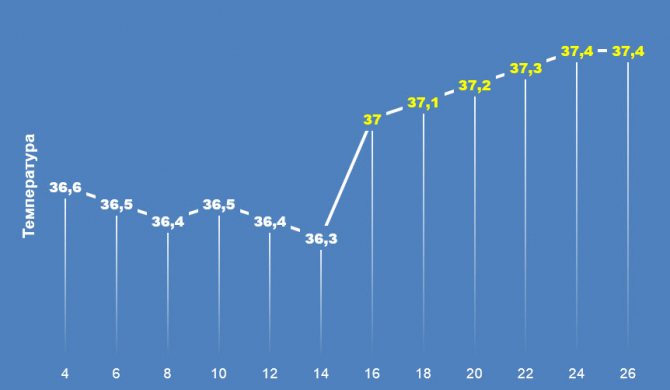
The fertile period is considered to be 3 days before ovulation (before the lowest temperature) and 2 days after.
If pregnancy does not occur this month, then 2 days before the expected date of menstruation the temperature again drops below 37 ° C. If you become pregnant, it will remain at the same high level for more than 18 days.
With the beginning of a new menstrual cycle, a new schedule is started. There are many ways to write graphically. You can get the form from your doctor or print this one .
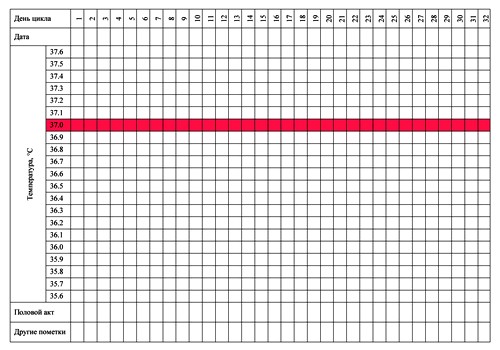
* The dots mark the received reading of your thermometer, then the dots between days are connected by a line.
If you had intimacy the day before, this is noted in the appropriate column.
Other notes include factors that could cause an accidental increase in basal temperature. These include:
- drinking alcohol;
- colds;
- infectious diseases of various organs;
- taking certain medications;
- travel and associated climate change;
- violation of the measurement rules discussed above.
The process of measuring basal temperature
It is best to start this process before your period. In this case, the following sequence of actions should be strictly observed, during which the basal temperature will be set with maximum accuracy:
- Regardless of the day of the week or any holiday, measurements are taken in the morning at the same time.
- The measurement is taken immediately after waking up, if you have slept for at least 3-4 hours.
- A special thermometer should be located near the bed in advance.
- You should not get out of bed until the measurement is completed, as this may increase the level of basal temperature and distort the readings.
- To obtain data, place the tip of the thermometer in the anus.
- Measurements are completed after 5-6 minutes. All this time you need to lie quietly on the bed.
- The data obtained during the measurement should be recorded in a specially prepared notebook. The process of measuring temperature can be clearly reflected by drawing a special graph.
Basal temperature and ovulation
Typically, many women use basal temperature readings to determine the time of ovulation. For this purpose, it is better to take measurements in the anus. The readings of a thermometer placed in the mouth or vagina will not provide the required accuracy.
In addition, it should be borne in mind that basal temperature may change due to the influence of certain external factors:
- if you are sick or have had severe fatigue before;
- if you drank a large amount of alcohol the day before;
- if you suffered from insomnia or went to bed very late;
- if there was sexual contact within 6 hours before measurement;
- if you are taking any medications.
A chart of readings will help facilitate the process of establishing the ovulatory phase. So, if the average basal temperature (not the one you measured before your period) is 36.5 degrees Celsius, and then sharply crosses the border of 37 degrees, the desired ovulation has most likely occurred.
If you take readings very carefully, you will most likely notice that there was a slight decrease in temperature immediately before. If a kind of zigzag appears on the graph, this is a sure sign that an egg has formed and is beginning to move through the ovary to the uterus.
With an average cycle length of four weeks, ovulation occurs on the 12th or 14th day.
Pregnancy and its effect on BT
Conceiving a child and the process of bearing it is associated with monthly cycles and has a great impact on all systems and organs inside the female body. Naturally, this cannot but affect fluctuations in basal temperature.
Therefore, if you systematically take measurements, it will not be difficult for you to determine the onset of pregnancy.
However, for this, as has been repeatedly said, the requirements for the measurement process and the subsequent construction of the graph must be correctly observed.
The appearance of pregnancy will cause certain changes in your schedule:
- Temperatures will exceed 37 degrees Celsius and will remain at this level for at least three days more than in previous months. That is, if before this temperature jump (that is, before the onset of ovulation) 12 days had passed since the last menstruation, and this month 16-17 have already passed, we should talk about the fact of conception.
- Pay attention to the number of temperature fluctuations during the menstrual cycle. The usual schedule consists of two waves, and pregnancy will be reflected on it in the form of an additional, third surge.
- Basal temperature is at a high level for more than three weeks - this is pregnancy.
Basal temperature during pregnancy and its changes

Not all women have an idea of what basal temperature is during pregnancy, and how basal temperature during early pregnancy or basal temperature during frozen pregnancy may differ.
But it is important to know not only for your health, but also for the condition of the unborn child, what changes are occurring in the body of the expectant mother.
What should you pay attention to first?
First, you need to understand what basal temperature is normal during pregnancy, whether basal temperature can decrease during early pregnancy, and what may ultimately be undesirable.
It is known that after ovulation, a thermometer, when measuring the temperature in the rectum or vagina, shows approximately 37.2 degrees. And just before the start of critical days, there is a decrease of several degrees, to approximately 36.7-36.9 degrees. This is due to the influence of hormones on the female body. At the same time, it is very important to know your individual indicators so that the basal temperature is noted in time when pregnancy occurs. An examination by a gynecologist can also help with this. You need to visit your doctor at least twice a year, even if nothing bothers you and there are no complaints.
How to correctly measure basal temperature during pregnancy or during pregnancy planning
It is important to follow simple rules. The measurement must be taken immediately after waking up, even if it is basal temperature during early pregnancy or simple measurements during the menstrual cycle. You can't get up. It is better not to even turn over on the other side, as this may change the temperature readings. It is recommended to prepare a thermometer in the evening and place it on the bedside table, and in the morning to determine the temperature data rectally.
The thermometer must be kept in the rectum for about five minutes. After this, be sure to record the readings in a table for later analysis by you or your doctor.
Remember that basal temperature during pregnancy can vary and fluctuate, especially if it is basal temperature during early pregnancy. And having a completed table at hand, you can always suspect something is wrong in time. And thanks to this, the basal temperature during a frozen pregnancy is very informative, and the risks for the female body will be much lower.
Normal basal temperature during pregnancy
You should approach pregnancy planning very responsibly. You need to monitor whether your basal temperature decreases or remains unchanged. If fluctuations are not noticeable for more than two weeks, then this indicates pregnancy. But there are also individual cases when menstruation then begins. It depends on the hormonal state of the body. The best thing is to do a test. But basal temperature during pregnancy is also good evidence that conception has occurred.
What determines the optimal basal temperature during pregnancy? Scientists have long determined that basal temperature during pregnancy after fertilization of an egg by a sperm first decreases slightly, but then increases again. This is due to the sequential release of estrogen and progesterone. The first lowers, and the second, accordingly, increases the temperature. This often occurs for just one day and is considered normal. Some women may not even notice this. So don’t panic if you notice a single and short-term jump in temperature readings.
Basal temperature during frozen pregnancy
Recently, unfortunately, there has been a tendency to increase cases when the basal temperature during a frozen pregnancy does not decrease to 36.7-36.9 degrees, but rises and shows such figures as if it were the basal temperature during pregnancy. In this case, fetal freezing is detected only with the help of ultrasound, during an examination by a gynecologist and tests for the content of hCG (human chorionic gonadotropin) in the blood and urine, the levels of which will be less than normal. So if a woman has a low basal temperature for a long time during pregnancy, she should immediately go to the hospital.
Basal temperature in early pregnancy
If a woman’s pregnancy is confirmed by a test and examination by a doctor and is proceeding normally, then the basal temperature during pregnancy, as mentioned earlier, begins to increase to levels above 37 degrees. But if a low basal temperature unexpectedly appears during pregnancy, this may indicate the occurrence of any deviations from the normal course of bearing a child. In this case, it is necessary to carry out a control measurement, and if you again see that your measured basal temperature during early pregnancy is below the established standards, immediately go to the doctor. A specialist doctor will conduct research and identify possible deviations or failures. Don't panic. We'll fix everything! But at the slightest suspicion, you need to remember that pregnancy at a low basal temperature is not the norm. This may be a signal of a non-progressive (frozen) pregnancy. Be careful and careful. Take care of your health!
temperature, pregnancy
